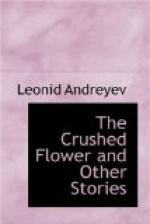He is a man of about twenty-six or twenty-eight, of pleasant appearance, and rather good manners, which show that he is a well-bred man. A certain quite natural unrestraint in his speech, a passionate vehemence with which he talks about himself, occasionally a bitter, even ironical laughter, followed by painful pensiveness, from which it is difficult to arouse him even by a touch of the hand— these complete the make-up of my new acquaintance. Personally to me he is not particularly sympathetic, and however strange it may seem I am especially annoyed by his disgusting habit of constantly moving his thin, emaciated fingers and clutching helplessly the hand of the person with whom he speaks.
K. told me very little of his past life.
“Well, what is there to tell? I was an artist, that’s all,” he repeated, with a sorrowful grimace, and refused to talk about the “immoral act” for which he was condemned to solitary confinement.
“I don’t want to corrupt you, grandpa—live honestly,” he would jest in a somewhat unbecoming familiar tone, which I tolerated simply because I wished to please the Warden of the prison, having learned from the prisoner the real cause of his sufferings, which sometimes assumed an acute form of violence and threats. During one of these painful minutes, when K.’s will power was weak, as a result of insomnia, from which he was suffering, I seated myself on his bed and treated him in general with fatherly kindness, and he blurted out everything to me right there and then.
Not desiring to tire the reader with an exact reproduction of his hysterical outbursts, his laughter and his tears, I shall give only the facts of his story.
K.’s grief, at first not quite clear to me, consists of the fact that instead of paper or canvas for his drawings he was given a large slate and a slate pencil. (By the way, the art with which he mastered the material, which was new to him, is remarkable. I have seen some of his productions, and it seems to me that they could satisfy the taste of the most fastidious expert of graphic arts. Personally I am indifferent to the art of painting, preferring live and truthful nature.) Thus, owing to the nature of the material, before commencing a new picture, K. had to destroy the previous one by wiping it off his slate, and this seemed to lead him every time to the verge of madness.
“You cannot imagine what it means,” he would say, clutching my hands with his thin, clinging fingers. “While I draw, you know, I forget entirely that it is useless; I am usually very cheerful and I even whistle some tune, and once I was even incarcerated for that, as it is forbidden to whistle in this cursed prison. But that is a trifle—for I had at least a good sleep there. But when I finish my picture—no, even when I approach the end of the picture, I am seized with a sensation so terrible that I feel like tearing the brain from my head and trampling it with my feet. Do you understand me?”




